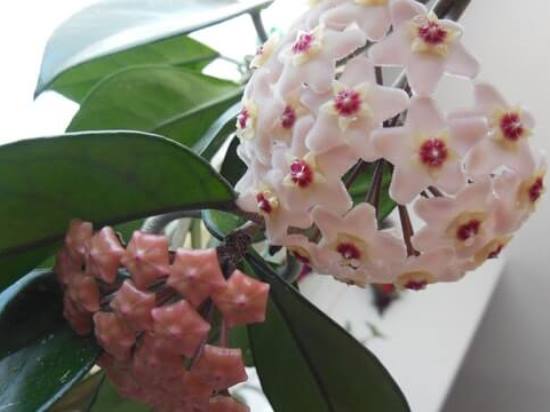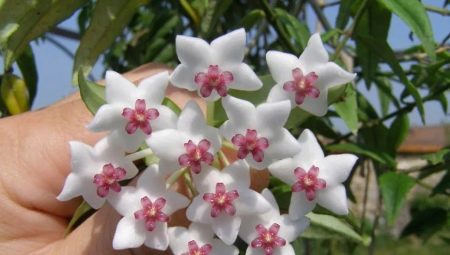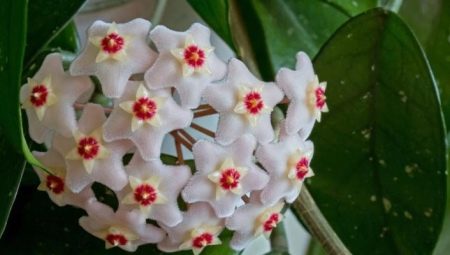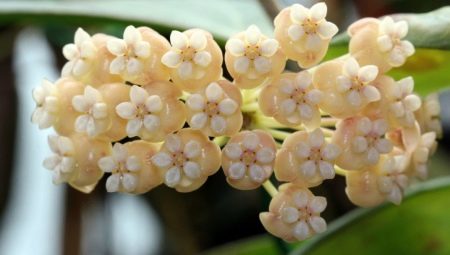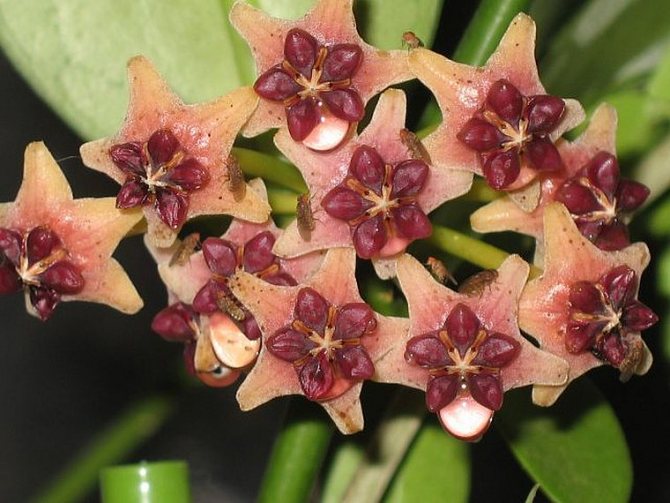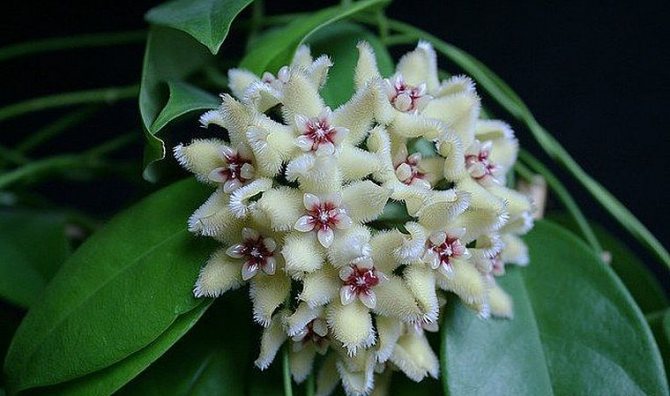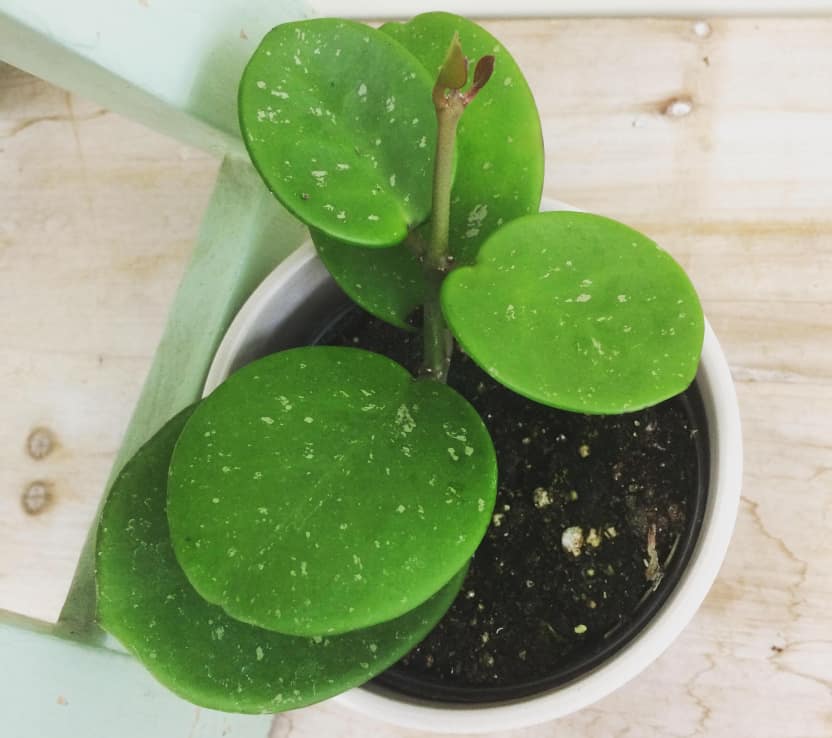Hoya care at home
How to care for a hoya
Different types of hoyi are grown in the culture, and each requires the fulfillment of its own conditions of detention, therefore it is difficult to give general recommendations for all types of recommendations. The only common wish for all plants of the Hoya genus is: avoid waterlogging of the soil, as a result of which liquid mud forms in the roots.
For convenience, we will divide the hoyi into categories according to the amount of moisture consumed and the required level of lighting:
- Indoor flower hoya with hard succulent leaves (fleshy hoya, kerry hoya). The optimal location is on the south window, under the rays of the sun. Watering is carried out after the top layer of the substrate has dried. An exception is the southern hoya (Hoya australis), which needs a constantly moist (but not wet!) Soil.
- Types and varieties of hoya with thin leaves (multiflorous hoya) require constant moisture from an earthen coma and shading from direct sunlight, an ideal place for them is an east or west window, and they will be fine on the north window.
- The houseplant hoya with light green pubescent leaves (hoya linear) grows best in the sun and requires regular watering without drying out the coma.
- Hoyas with dark green pubescent leaves (Thompson's hoya, serpentine hoya) love shady coolness and regular watering without overdrying the earthy coma.
As for the comfortable temperature for hoya, in summer it is 17-25 ºC, and in winter - not lower than 10 ºC, although it would be better to slightly higher - about 15 ºC. The exception is the beautiful hoya (Hoya bella), which loses its leaves from the cold.
At home, the hoya does not have a pronounced dormant period, but if you notice that the plant has slowed down, reduce watering and stop feeding - let the hoya rest. Usually, the hoya stops growing when the daylight hours becomes short, but if you decide on the issue of additional lighting for the plant, the hoya may skip the dormant period.
Hoya fertilizer
In nature, different types of hoya grow in different places, in different soils, and therefore need different types of fertilizers. But according to many observations, the results of which have been published, it is best to feed hoya with fertilizers for flowering succulents - all species respond well to them. And if you regularly transplant hoya into a fresh substrate, then you can not resort to top dressing at all.
Hoya transplant
Young plants are transplanted annually in spring, and adults - once every three years, if necessary. A large hoye pot is not needed, but buy a new pot for transplanting each time - the one left after any other plant is not good. And even a new pot must be thoroughly washed with ordinary soap before being transplanted into it, and the substrate must be sterilized.
Hoya soil needs breathable, neutral or slightly acidic reaction, preferably of this composition: one part of humus and leafy soil and two parts of clay-sod, but many grow hoya in an orchid substrate and even just in garden soil - it all depends on the type of hoya, therefore approach plant transplantation creatively, having previously studied in what conditions and in what soil your hoya grows in the wild. A drainage layer is laid at the bottom of the pot, the plant is rolled into a new pot along with an earthen lump.
Care
Hoya Kerry cannot be called a capricious plant, caring for her is very simple. The plant will grow without special conditions, but beauty and flowering can only be achieved by maintaining comfortable conditions.In winter, like many plants, Hoya falls into a dormant period. Care at different times of the year has its own differences. During sleep, it is advisable to do practically nothing with this plant.
Conditions
Soil for Hoya can be purchased ready-made, the one that is harvested for cacti is suitable. To improve air permeability and promote some water retention in the soil, simply add shredded bark or charcoal to the soil.
An ideal place to grow would be the east or west side of the house.
It is important to have only diffused light, shadow or direct sunlight will be destructive. Despite the fact that the plant is native to the southern countries, high temperatures are undesirable for it.
A sufficient temperature will be 23-25 degrees in summer and 16-18 degrees in winter. If the temperature drops below 16 degrees, the plant is threatened with death.
Watering
Watering should not be frequent. Just 1 watering every 7 days is enough. In winter, the amount of moisture is reduced to 1 time in 2 weeks. Once the soil is dry, it can be moistened again.
If you cannot determine how much water your flower needs, pay attention to the condition of its leaves. Wrinkled sheets indicate a lack of moisture, and sluggish sheets indicate an excess of moisture.
Fertilizers
You can feed Hoya even during its flowering period. We select the composition, as with the soil - fertilizers for cacti. This fertilizer must include potassium. Experts are still arguing about the frequency of fertilization. Some say that only 1 time per month is enough. It is better to fertilize less often, since an excess of fertilizing is very harmful to plants.
Transfer

Hoya Kerry needs to be transplanted only when necessary. The succulent pot also needs to be changed rarely, once every few years is enough. Young plants are transplanted a little more often - only once a year. Even a new container should be washed with soap and water before planting, and the old one is sterilized.
When transplanting, do not remove the old soil from the roots of the vine, as you can damage them, which will lead to the death of the flower. The transplant should be carried out in the spring, when the flower wakes up after hibernation. It is undesirable to touch the plant in winter and summer, when it is in the active flowering stage.
Pruning
Any pruning will only have a negative effect on this vine. Pruning is sometimes necessary, but only if:
- diseased areas on the plant;
- the need for an escape for reproduction.
Old inflorescences do not need to be removed. Next year, a new flowering will begin at the same place.
What a flower looks like: description and characteristics
Hoya Lacunosa, or concave hoya, is an evergreen tropical vine that belongs to the subfamily of the Asclepiadoideae and the Apocynaceae family. Natural habitat - India and China, Singapore, Malaysia, Indonesia, Thailand, Java islands, Sumatra, Borneo.

Hoya Lacunosa is considered the most popular vine
Epiphyte settles next to large trees that support it. Under natural conditions, it enters into symbiosis with ants living among its roots. The dark green leaf has a hollow, hence the name concave (lat. Lacuna - "hollow").

Hoya leaves concave very dense to the touch
The front side of the sheet is matte, and the back is shiny. The length of the leaves is up to 6 cm, the width is up to 2.5 cm. The young growth is colored red-brown, gradually becoming dark green. Numerous lashes form a dense, practically non-curling falling cascade.
Stems are green or with a reddish tint. It blooms with inflorescences of white or pinkish shade, 15-20 pcs. on thin rod branches. Produces a pleasant aroma that intensifies towards night.
The most common varieties:
Tove
Krona is distinguished by its miniature size compared to other varieties. The leaf has a characteristic purple color, which appears brighter in the sun. The inflorescence is cream colored with a yellow core.Each flower is 6 mm in diameter, and there are more than 20 of them in the inflorescence.

Hoya lacunosa Tove very small
Snow caps
Beautiful silvery leaves are up to 5 cm long and up to 2 cm wide. The flowers are boiling white up to 10 mm in diameter. It is considered a slow growing variety.

Hoya lacunosa Snow Caps - slow growing cultivar
Hoya Eskimo
The diamond-shaped glossy sheet has chaotic silvery-greenish spots that acquire the greatest contrast in diffused but bright light. The flowers of the hoya Lacunosa Eskimo are white - standard for this species. If the silvery part predominates on the leaves, then the variety is called with the prefix super (super) or silver (silver).

Hoya lacunosa popsicle with spotted leaves
Royal flush
Leaves are dark bronze in color with small silvery blotches up to 6 cm long. Inflorescences are white. Young growth in Flash (Flash, or Flash) has a reddish-brown color.
Picture 6 Hoya lacunosa Royal Flush with classic white flowers
Since 1826, the plant has been described in botanical reference books and is cultivated in greenhouses and in homes. The selection of new varieties was carried out along the way of obtaining vines with bright variegated leaves.
Note! Hoya is poisonous. It is not recommended to start it in a house where small children and pets live.
During flowering, the vine emits a very strong aroma, so you should not place it in the bedroom.
How does it multiply
Regardless of the variety chosen by the florist, the reproduction of vines occurs easily and without complications.
Germinating seeds
Finding hoya seeds on sale is a great success. It's all about their short shelf life. Usually, in nurseries, they are slightly dried after collection and immediately sown. Seedlings appear in a week.
Rooting cuttings
The optimum length of the cutting is 5 cm. It can be germinated in water or in a damp substrate. The first roots should appear within a week. To maintain optimum humidity, the rooted cuttings are covered with transparent caps.
Sheet
If it is not possible to cut the stalk, then you can try to root a healthy leaf. It is pinched off with the longest petiole, which is dipped at an angle into the ground and covered with a bag or glass jar.
Note! Unlike propagation by cuttings, propagation by a leaf takes 3-4 times longer.
Other options
Hoya can be propagated by layering. Scourges willingly release air roots, so they are easy to root, just put an additional pot next to it. The branch is bent to the soil and secured with a hairpin. The rooting process takes about a month, after which the new plant is cut off from the mother.
Care
At home, growing hoya does not cause serious difficulties, but it requires adherence to the nuances of care. Since the flower is of tropical origin, it is extremely sensitive to cold weather. With abundant moisture in the soil and air, the plant is able to withstand a fairly high level of temperatures. Optimal living conditions vary:
- from +17 to +22 in the spring-summer period;
- from +16 to +18 in autumn and winter.

As for the location, it largely depends on the lighting conditions. This moment is thought out even before the purchase of a flower. Direct-spectrum sun rays harm the development of the plant, especially in the hot season. Therefore, in the summer, in no case place the indoor beauty on the window from the south. The best option is a window from the west and east
It is important that the hoye kerry has enough diffused light, then it will bloom profusely annually.
There is no need to increase the humidity level, average parameters are sufficient. At the same time, the plant loves water procedures, which should be carried out regularly: shower with warm water, spraying. Ideally, this should be done every 7 days. Do not spray the inflorescences or wipe off moisture from them if you do not want to spoil the decorative appearance of the flowering. Watering is done with the same frequency, if the leaves do not indicate a lack of moisture by their shriveled appearance. In winter and autumn, the soil is moistened every 14 days.The water should be separated, at room temperature.


During active growth and flowering, hoya is fed with mineral preparations. Fertilizers are suitable for succulents and cacti, with potassium.
As for pruning, you should be careful here and not subject a healthy flower to this procedure. Diseased leaves and shoots are removed for reproduction. You should not even separate the wilted inflorescences.


Description
Hoya should be classified as an evergreen vines of tropical origin. The plant gained its popularity thanks to its beautiful heart-shaped leaves. Each such leaf has good fleshiness, and its length is about 15 cm. Hoya Kerry has several subspecies that have their own differences. The difference lies in the color of the foliage, which is often covered with blotches, may be variegated or have white edges.
The owners, who are distinguished by their scrupulousness, will definitely have to see the flowering of this vine. Flowers grow small. The color saturation will depend entirely on the amount of light received. The flower shapes are somewhat star-shaped. Flowering occurs from June to October. The most voluminous bloom can be observed from July to September. During this period, the inflorescences emit a large amount of nectar, which has a rich caramel aroma.
Hoya breeding
Hoya from seeds
How to propagate hoya if you happen to be the owners of a rare treasure - hoya seeds? Ripe and well-dried hoya seeds in the year of their harvest are sown in a loose substrate consisting of an earthen mixture and chopped sphagnum moss. Seeds germinate within a week, and as soon as shoots appear, you must ensure that the soil in the crops never dries out and at the same time is not wet. Keep the seedling dish in a warm, bright place.
To prevent fungal diseases, spray the seedlings with Bordeaux mixture or any other copper-containing preparation in strict accordance with the instructions. After 90 days, when the seedlings release several pairs of leaves, they are planted in personal pots. However, growing hoya from seeds is hampered by the fact that it is impossible to find seed on sale, and it is almost impossible to get seeds from a hoya growing at home.
Hoya propagation by cuttings
This is the easiest and most reliable way to get a new plant, since hoya cuttings take root easily. The stalk should be short, but have at least two nodes and one or two pairs of leaves. You can root cuttings in water or in a substrate. For rooting in water, wrap the container with foil on all sides, making holes for the cuttings. Leave only the top pair of leaves on the cuttings, treat the bottom cuts with root hormone, and push the cuttings through the holes in the foil so deep that the bottom node is in the water.
The temperature for rooting should be no higher than 22 ºC, but high humidity is also important for this process, otherwise the cuttings will simply fade. To increase the air humidity, put a transparent plastic bag on the container with the cuttings, but do not block the air flow under it.
Hoya rooting occurs after two weeks, and it is important to transplant the cutting to a permanent place at an early stage of root formation, otherwise the cuttings become fragile and break
How can you root hoya immediately in the substrate? The rooting soil must be so permeable that excess water can easily flow through it. Treat the bottom cut of the cuttings with a root root before planting. Sterilize the substrate and pot, and place the cutting in the soil so deep that the lower node is in the soil. If the air humidity in the room is low, loosely place a transparent bag over the cuttings pot. After 2-3 weeks, signs of new growth should appear. If you received rooting cuttings in the mail and it seems to you that they are too dry, soak them for several hours in slightly sweet water, and they will restore their moisture.
Hoya care and reproduction at home (with photo and video)
All wax ivies are ornamental plants. Growing hoya at home is possible both in warm, temperate and cold (H. carnosa) greenhouses, and in rooms (they easily tolerate dry air).
As shown in the photo, when propagating hoya, cuttings are cut with one or two pairs of leaves, but longer ones can be used:


The substrate for grafting is made up of peat and sand (2: 1). The appearance of roots at petioles does not occur at the nodes, but between the nodes, therefore, the cuttings are cut not under the node, but below the node. The optimum temperature for rooting hoya when grooming at home is at least 20 ° C. Cuttings of wax ivy are easily rooted in indoor conditions (they can also be propagated by air layers, as well as by leaves with an axillary bud).
Here you can watch a video of the breeding of various types of hoya:
Rooted (on the 20-25th day) cuttings are planted in 9-cm pots. The composition of the land is as follows: turf - 1 part, leaf - 2 parts, humus - 1/2 part and sand - 1 part. Plants need abundant watering, especially during periods of intensive growth. The location is recommended to be bright, if possible sunny. In winter, watering is limited, but the earthen lump is not brought to complete drying. The temperature for all wax ivy must be at least 16 ° C (with the exception of H. carnosa, it is kept at 13 ° C). In summer, in addition to abundant watering, spraying of plants and airing of the room is necessary; the optimum temperature for their growth and development is 22–25 ° C. Plants bloom profusely. A strong support is required to keep the plants upright.
These photos of hoya care at home show all the basic agricultural techniques:


Young plants are transplanted annually, as they develop intensively in bulkier containers; mature plants are transplanted once every three years. To enhance the growth of vegetative shoots, fertilizers are applied 2 times a month, from April to September. As a fertilizer, a complete mineral fertilizer is used at the rate of: 40 g per 10 liters of water, once a month, secondarily - slurry. High light intensity (bright windows in rooms) activates the formation of flower buds. Flowering continues until autumn. After flowering, the flower stalks should not be removed, since next year buds - flowers appear on them (the abundance of flowering in the rooms is stimulated by immersing the plants for 30 minutes in warm (35 ° C) water, in spring and autumn).
Watch the video of hoya care at home to better understand how to grow this flower:



